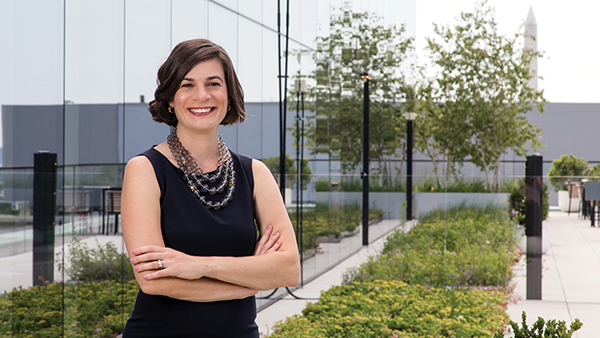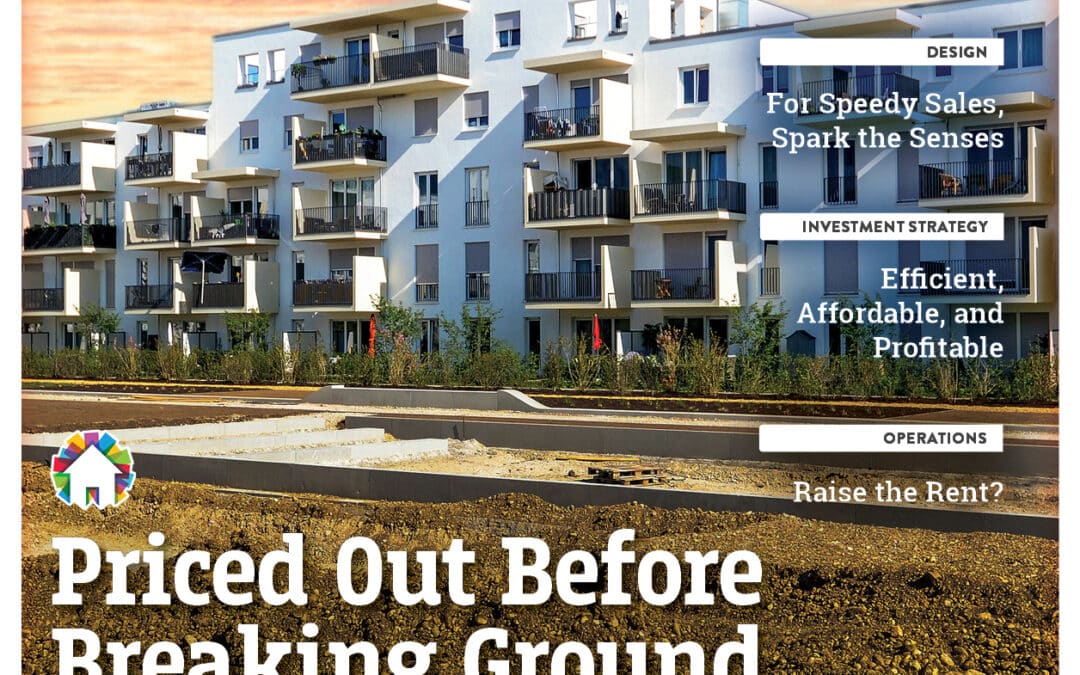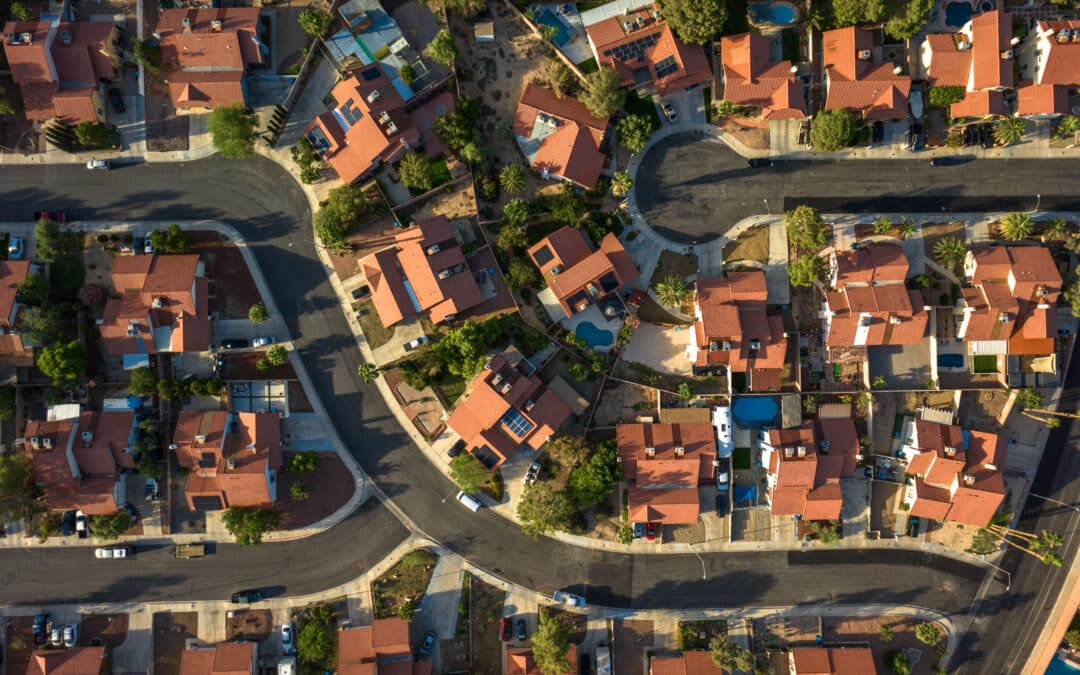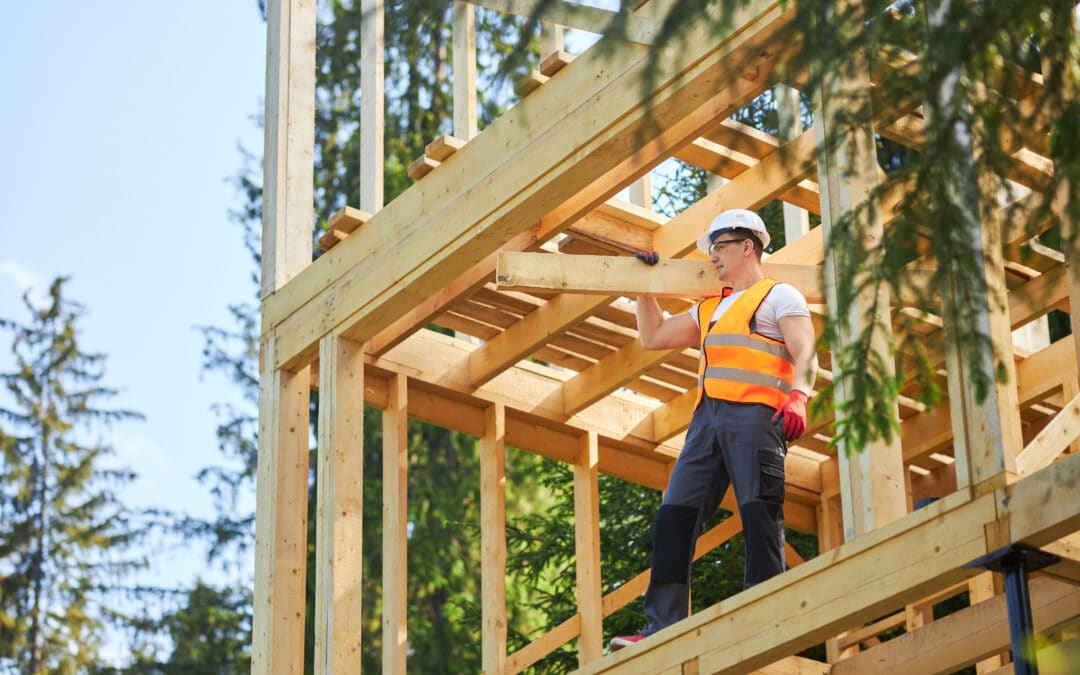Photos by Beth Caldwell.
When Chrissa Pagitsas first took on her executive leadership role at Fannie Mae in 2010, there was no existing road map to show how she should deliver on her mission: positive environmental and social outcomes through mortgage finance.
“When I came on board there wasn’t the focus there is now on green finance,” said Pagitsas, Vice President of Enterprise Environmental, Social, Governance at Fannie Mae. “We knew that green finance would play a critical role in our support of the housing industry, but there was no blueprint with a specific design. We were working from scratch.”
While challenging, the amorphous prompt was veiled good fortune. Ultimately, it afforded Pagitsas the creative latitude that enabled her to take a broader, benevolent tack. Pagitsas said she could step back and evaluate a mortgage product’s offerings, the people it would benefit, and the process to make it happen.
“What I thought about when I first started this back in 2010 is how can we get what’s called the “triple bottom line” out of a boring old mortgage,” Pagitsas said. “How do we get financial benefit and profitability? How do we get social benefits with better quality housing that’s more affordable for American renters? And how do we get environmental benefits as a result of energy and water efficiency?”
The answers didn’t arrive overnight, Pagitsas said. But, eventually, they culminated into what’s widely regarded as one of the most successful green financing programs ever: Fannie Mae’s Multifamily Green Financing Business.
Through year-end 2018, the program has financed more than 2,000 multifamily properties through $51.7 billion in green mortgage-backed securities, spurring investor profits, societal improvements, and substantial environmental benefits.
But as with many lofty plans aspiring for bold goals, Pagitsas and her team at Fannie Mae would face a variety of challenges. They’d have to overcome not only market complacency and competition, but also the challenge of simplifying a convoluted package of benefits.
 An Idea Takes Root
An Idea Takes Root
Fannie Mae — a government-sponsored enterprise also known as the Federal National Mortgage Association — launched its Green Financing Business first as an initiative in 2010 and issued its first Green Bonds in 2012.
In essence, the challenge was how could Fannie Mae help transform an aging housing stock into better, more affordable and more environmentally sustainable homes for Americans? By retrofitting existing properties and building new green-certified properties, Fannie Mae would help create new jobs, cut utility costs, reduce energy and water use, and cut greenhouse gas emissions.
Thus, the company first set out to explore how financing for environmentally sustainable projects can support quality, affordable housing in the U.S., Pagitsas said. To learn more, Fannie Mae established the first Green Rental Housing Task Force, which convened housing, energy efficiency, and mortgage industry experts to discuss needs and a national strategy.
With more than 15 years as an energy and utilities executive, Pagitsas was ready to coalesce the collective knowledge into a meaningful program that made a difference.
“Because of my background in the energy sector and as a consultant to real estate companies, I knew we could do more,” she said. “[The program] had to be grounded in a mortgage that was easy to use and rigorous at the same time. It wasn’t going to be about greenwashing, hand-waving and green paint. It was going to be a mortgage that delivered a better quality property, a more environmentally sound property, and also a more affordable property.”
The initial launch illuminated the challenge of presenting a program whose intricacies can be intimidating and painful, Pagitsas said.
“Nobody wants to get a root canal right?” she said. “But energy efficiency financing is pretty much akin to getting a root canal. Historically, it has been a separate process. It’s standalone and it’s different.”
Pagitsas said she focused on three “Ps” to simplify the pitch: The product, the people, and the process. She made it a goal for her team and Fannie Mae’s network of 25 multifamily lenders to be able to describe the program in about 30 seconds, which helped simplify its value to borrowers. Pagitsas wanted to create a straightforward and attractive mortgage product that delivered value to borrowers and to society while benefitting the environment.
While the mindset shift was helpful, the program’s adoption by lenders and borrowers initially faced headwinds thanks to economic uncertainty amid the financial crisis.
“New products were not a top priority — it was about steering the ship soundly and safely,” Pagitsas recalled. “New concepts were questioned.”
To further illustrate her point to her team and Fannie Mae’s network of 25 multifamily lenders, Pagitsas used an example: If a property owner were to install something like a new heating, ventilation, and air conditioning system for an apartment building, it can not only increase the value of a property, it can also reduce its operating expenses and credit risk. It also can help tenants by reducing their energy bills as well as aid the environment by curbing water use and greenhouse gas emissions that contribute to human-caused climate change.

Chrissa Pagitsas brainstorming with Samantha Thompson (left) and Abou Bakayoko (right).
When Pagitsas used that approach, she said people began to buy into the idea.
“When I explained it through that lens, the understanding started to grow,” Pagitsas said. “It’s not green paint. It’s actual capital that’s working to do something of value, which is creating better cash-flowing properties that reduce cost burdens on American families. By framing the benefits internally to colleagues through that lens, and then talking about it that way to our lenders, who hadn’t thought of this stuff before, they were able to see the value and sell it to borrowers.”
Branching Out in Impact
It took several years for Fannie Mae’s Multifamily Green Financing Business to take root, according to the organization’s data. Between 2012 and 2015, Fannie Mae generated only 4.7 percent — or $245 million — of its total securities issued through year-end 2018.
But thanks to Pagitsas and her team’s determination, Fannie Mae stayed the course with its two, green mortgage-backed-securities products.
Green Rewards — of which Fannie Mae has issued a total of $42.4 billion in financing through 2018 — supports the transition of existing rental housing to a low-carbon economy through investment in energy and water efficiency retrofits and renewable energy generation. The Green Building Certification — of which Fannie Mae has issued a total $9.3 billion in financing through 2018 — may be newly constructed or retrofitted housing if it meets specific criteria.
Combined, Fannie Mae has issued $51.7 billion in green mortgage backed securities and an additional $6.1 billion in green structured securities. Those whopping totals made Fannie Mae the largest green bond issuer in the world in 2017 and 2018, according to the Climate Bonds Initiative.
The successes of the program have far exceeded Pagitsas’ expectations.
“It is really fulfilling to see this work being realized,” Pagitsas said. “In 2016, I was thrilled to hit $3.6 billion. That was a high watermark for me. I couldn’t believe it when we hit nearly $28 billion in 2017. So here we are in 2019, and our numbers through the first quarter are more than $54 billion in green financing.”
Perhaps equally impressive are the positive economic reverberations from Fannie Mae’s Multifamily Green Financing Business.
Newly constructed or retrofitted green multifamily buildings financed by Fannie Mae are estimated to have contributed $7.2 billion in workers’ income, according to Fannie Mae’s Multifamily Green Bond Impact Report. They’ve added about $14.6 billion to the United States’ gross domestic product and supported or created 170,000 jobs to build or retrofit more than 550,000 apartment units, Fannie Mae reported.
Fannie Mae estimates that owners who made their properties more efficient through green financing are projected to recoup their investment within six years on average. Tenants at these properties are projected to see annual utility expenses cut by about 10 percent or $145 on average.
Pagitsas — a mountain biker and former collegiate sailing captain — is also thrilled at the program’s staggeringly positive environmental impact, in addition to its business success.
“Yes, I’m a tree hugger — a tree hugger that sees value in profitable businesses,” she said. “The two are not incompatible in my mind.”

The projected environmental impacts from the $51.7 billion of Fannie Mae Green Bonds are estimated to have saved about 4.3 billion kilo British thermal units (kBtu) of source energy each year. That’s enough energy to power about 1,454 homes for an entire month, according to data from the U.S. Energy Information Administration.
In other savings, the program is projected to have cut about 5.9 billion gallons of water use annually, which is equivalent to filling the 8.5 acre Bellagio Fountains in Las Vegas 269 times over, according to data from WaterSmart.
It has also reduced greenhouse gas emissions by 287,000 metric tons, which is equivalent to driving nearly 61,000 passenger vehicles for one year, according to data from the Environmental Protection Agency.
Such metrics have earned Fannie Mae more than a dozen national and international commendations recognizing its multi-year commitment to creating environmentally sustainable, healthier, and more affordable U.S. housing. Most recently, the program was recognized at Climate Bonds Initiative’s Green Bond Pioneer Awards for its role as the largest green bond issuer worldwide and for instilling transparency to the growing market.
Pagitsas also earned the CBI’s “Green Bond Champion” award in 2019 for her role in bringing structural diversity and innovation to the market in 2018 through Fannie Mae’s multifamily green mortgage finance program.
While she loves to highlight the environmental and social benefits, Pagitsas said the numbers also tell another compelling story of determination.
“What this should tell people is that this isn’t a one-hit wonder,” she said. “If we had done $3.6 billion in financing and had never done another loan, then I hadn’t built a simple, elegant, competitive product. What it’s shown is that the product is attractive and that the process is simplified … It’s really about a new way of doing business.”
 What motivates her passion for this work? Pagitsas loves to help connect people and their expertise to make a difference and create new ideas.
What motivates her passion for this work? Pagitsas loves to help connect people and their expertise to make a difference and create new ideas.
“I consider myself to be a horizontal thinker. I’m someone who thinks across different knowledge bases to connect the dots to create new products and bring new ideas to market,” she said. But the deep-dive into one area of mortgage financing is a great thrill too. “We’ve got underwriters with 20 years of experience underwriting loans and they’ve seen it all. I enjoy sitting down with them, and because they know so much, I can say ‘What about this idea? … And they can throw things at it and make it better.”
Looking ahead, Pagitsas is excited to grow the impact of Fannie Mae’s Multifamily Green Financing and help other real estate organizations make positive environmental impacts.
“The bottom line is that Fannie Mae’s committed to this,” Pagitsas said. “We were the first ones to issue an agency green commercial mortgage-backed security back in 2012 and we’ve been leading the market ever since. With that leadership comes the opportunity to create new products, but also to share knowledge with others that are seeking to replicate what we’ve done. And I welcome the opportunity to share with others.”
Pagitsas said she’s encouraged to see not only her colleagues, but other industry leaders embrace environmentally sustainable financing programs and a collaborative approach to achieve their goal. The real estate industry is unified around the idea that there is a housing crisis in the United States, and we need solutions to it, she said.
What’s more, Pagitsas said she’s excited to see borrowers flock to Fannie Mae’s green financing options — thanks in part to their business advantages, but also for their societal and environmental impact.
“At the end of the day, Fannie Mae developed a better, faster, more attractive product that caught borrowers’ eyes. They voluntarily chose it. This isn’t government mandated. There are no quotas. This is all about market forces and thinking of new innovative ways to spur investment in better quality assets that result in affordable housing,” she said.


 An Idea Takes Root
An Idea Takes Root





















0 Comments